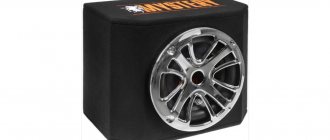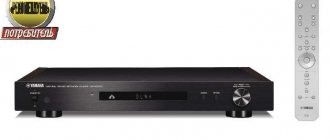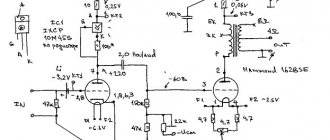Greetings from Aunt Sony (Sony TA-F555ESL amplifier)
We present to your attention an exercise from “Alex” Akimov.
At first he thought that Mosfets devices from Sony were just good, but then he bought an MC head and... To find out what happened next, read and comment. To fill a certain gap in experience, namely: what is the sound of amplifiers based on field-effect transistors (aka MOSFETs), I decided to test one of Sony’s top-of-the-line amplifiers. The choice was between the TA-FA3ES, TA-FA5ES and TA-F555ESL models. After some deliberation, the choice fell on the latter. Why did I choose the oldest device? I answer. TA-FA3ES, despite the fact that it was the youngest, and also completely (!) new (the device lay sealed in a warehouse for about twenty years) was still of a lower level than TA-FA5ES and TA-F555ESL, so the choice was mainly between these two models. And if the presence of side decorative overlays on the 555 had nothing to do with the sound, then the anti-resonance G-chassis (and, accordingly, greater weight), plus the lack of electronic switching (the device has a motorized input switch and, similarly, a motorized ALPS volume control) in the end they seemed like strong arguments in favor of the 555th.
Of course I heard what all these amplifiers sound like. But, firstly, this was in the now distant 90s.
Secondly, then it never occurred to me to compare something with anything else, and thirdly, the circuit and the listening room, or rather the lack thereof. After all, you can’t take the sound of a device seriously in a huge store hall. And the entire line of SONY amplifiers presented in that store at that time were exclusively European versions, and as you know, they are often very different from the models made for the domestic market. However, at that time I not only didn’t know about it, but didn’t even guess. And now interest in the topic has returned in a new round and, alas, not from a good life. The events of the last three or four years have driven prices for new equipment to such heights that most people who are passionate about this topic had to turn their attention to the secondary market. Including devices aged 20 years and above. So what is this amplifier model, which was very popular in the early 90s? The main difference between the ESL modification (this can be attributed to ESA and ESJ) is the output stage based on field-effect (MOS) transistors (aka MOS FET). The phono stage is also built on them.
Other models of the 555 family (ES, ESG, ESR, ESX, as well as their modifications with Roman numeral II) are implemented on bipolar transistors, and these, as they say in Odessa, are two big differences. Accordingly, despite the external similarity, we have different circuitry and, accordingly, different sound.
Sony 555ESX filling, two new transformers, two mink coats...
Comparing devices within the line with each other is absolutely pointless. Every technical solution has its supporters and its opponents. I will express my own point of view on this issue later, but for now some dry numbers. Output power 2x170 W (4 Ohms) 2x140 W (6 Ohms) 2x120 W (8 Ohms) These figures personally seemed to me a little high at first, but certain points convinced me that everything was really so. To summarize: The output power is SUFFICIENT. Dimensions of the device: 470x170x435 (together with side decorative overlays) Weight: 24 kg (no doubt about it - it’s heavy, it’s an infection). Naturally, there is an MM/MS phono preamplifier on board and... hello to the nineties, I finally came across a vintage amplifier with a remote control. If anyone is interested in other numbers, you can easily find them on the website audio-heritage.jp or any other similar one. I'm interested in sound. So let's talk about it. At first, this testing was intended, one might say, “for show.” But “Galochka” turned out to be a very colorful girl. True, before I could find out, some troubles happened. The date of acquaintance was postponed several times for various but valid reasons. And even when it seemed that the acquaintance should have taken place 100%, suddenly a buyer was found for the device prepared for the test. Luckily there was another copy available. But it has just arrived from its historical homeland and, accordingly, has not yet undergone the necessary procedures (cleaning, preventive maintenance and a full performance check in all modes). I had to wait a couple more weeks, and wait and catch up, as you know... In general, after all these moments, I got a little cold and when the device was finally installed on my rack with equipment, at first I didn’t even expect any revelations. To say that the surprise that awaited me was pleasant is to say nothing. I honestly tried to find at least some flaw in the sound. I tried...and couldn't find it. Of course, if I were to judge the apparatus “according to Hamburg standards,” it would be quite possible to find shortcomings. But I always want to be as objective as possible, and therefore, if you take into account the quality/price ratio, and it was 138,000 yen in 1990 and an average of 40,000 rubles nowadays on the secondary market, then it’s not easy to find a competitor for this device (in this case I’m talking about devices built specifically on field-effect transistors).
Among modern devices, they simply don’t exist (for 40 thousand rubles). They are not among the “vintage” ones... well, except perhaps Sansui, although prices for Mosfet Sansui usually start at 60 thousand. Whether they are better can definitely be said only after comparative listening. I will say more, having already heard a lot of devices from a higher price segment, I still cannot find a clear explanation for this phenomenon. But I'll try anyway. First of all, the TA-F555ESL has its own sound signature and this is undeniable.
Filling Sony 555ESL
This signature is inherent in all Sony “mosfets” amplifiers, or “mosfets” in general, I don’t know yet. To do this, you need to listen to at least several devices made on the basis of field-effect transistors, and so far I have only listened to one. Definitely an “audilomaniac” amplifier - when I started listening, I woke up a few hours later and realized that I was listening to the music as a whole, and not individual moments, although from time to time I paid attention to these moments.
So, with the resolution of the device, in my natural opinion, everything is in perfect order. It is perhaps a little lower than that of the DENON PMA-970 standing next to it, but there are nuances here.
The fact is that Denon presents everything evenly, without any noticeable protrusions or camouflages. Typically audiophile contemplative and analytical manner. And in principle this is also good. The sound of SONY is different, it is indeed more “tube”, but not so much in softness as in the manner of presentation. Solo instruments are presented in an accentuated, convex, palpable way. It is this emphasis that somewhat sets off the background sounds, which can be perceived as lower resolution. But in my opinion this is not entirely true. Otherwise, everything is quite balanced - no obvious distortions - everything “what the doctor ordered”. Although there is still a slight coloration in the sound. But the way SONY builds the scene is a whole different story.
Filling Sony 555ESL
I have never seen such an interesting (in a good way) depiction (we are talking about devices in this price category, born in the 20th century). Initially, I didn’t even think that I would seriously compare this amplifier with my tube Melody, which is at least three times more expensive. Nevertheless, I compared it. Yes, there are similarities, but differences, of course, are also present. Vocals on a tube amplifier do not sound as beautiful as on SONY (it does tint it, as I mentioned above), but more honestly. And the tube amplifier presents the rest of the sound material without frills. Although what is better in this case, everyone decides for himself. As a result, the SONY TA-F555ESL seems to be a completely reasonable compromise, a kind of “golden mean” for poor adherents of two polar concepts.
But if, without any conventions and false political correctness, then: If you perceive music more on an emotional level, and your budget does not allow you to buy something “cool,” buy a similar device and you will save money, nerves, etc., and in return you will get something more, good a mood that visits us less and less as we age. If the priority is thoughtful analytical listening, SONY is clearly not designed for this and it is better to choose something with classic bipolars. But let me return to the shortcomings that I still found. True, on the second day of listening, which once again confirms the rule: any device needs to be tested for several days to understand its essence. Most of these deficiencies found could be considered relative. Relative because someone will not consider the following as shortcomings and would rather attribute these points to individual characteristics. I, too, am more inclined to the latter... Appearance. If the device had a silver facade, it would look much more advantageous than with a black one; this color is clearly not designed to somehow highlight the amplifier in the interior. Although interiors can also be different, and perhaps in a bright room and even with an abundance of light furniture, a black rectangle will look appropriate. And with a silver facade there are only modifications ESA and ESJ, which except for the color are practically no different from the ESL, but at the same time noticeably more expensive. Well, the Japanese love silver. And they appreciate it.
Temperature conditions are another analogy with a tube amplifier. During operation, the device heats up quite noticeably - in this it is comparable to amplifiers operating in pure class “A” and with the already mentioned tube amplifiers.
Moreover, the younger model, namely the 333rd, heats up noticeably less. True, the no-load current in the 333rd is 30, and in the 555th this value is already 45 milliamps, and the output power is also different.
There are other differences, but at the moment I am not comparing these models with each other. So, due to the fact that the device heats up quite noticeably, it is DEFINITELY not worth installing it in a closed rack, much less placing something on top of it. At least personally, I wouldn't do this. The device requires warming up. Simply pressing the power button and turning the volume knob is not enough for “Sonka” to start playing right away as expected.
It takes time for it to enter operating mode (another parallel with the lamp). True, 10 minutes is usually enough. At least by ear. It also seemed to me that this amplifier does not really like poorly recorded soundtracks. Although, on the other hand, who loves them? It’s just that some devices disguise this matter. But this is clearly of no use to amplifiers from a higher segment. Well, this amplifier still has certain genre preferences. Which is a separate conversation and it is better to conduct it outside the scope of this test. Moreover, for now this is purely my opinion, and it can only remain mine. I was also not particularly impressed with the sound at low volumes. This amplifier does not have a loudness button or a corresponding mode, so it is definitely tailored for those who like it louder. And finally the tract. Is it correct to test an amplifier with a source that is four times more expensive than this amplifier (we are dancing on retail prices) and acoustics that are twice as expensive? As for the acoustics, I’m convinced that this is correct, although the owners of this amplifier probably prefer simpler speakers. As for the source, I think it’s incorrect, although journalists in the audiophile press do not disdain such misalliances. On the other hand, such an environment probably squeezed out of the amplifier everything it was capable of. Well, or almost everything. How he will end up in the company of companions who are closer in price is a big question. But the potential has been revealed, and this is the main thing.
Well, and the phono stage, which, as always, is left for dessert. Although it is possible that it was possible to start with it. The fact is that the new owner of that very first copy, who, instead of going to me, went to the glorious city of Novokuznetsk, sent an enthusiastic review specifically regarding the phono stage of this amplifier (we will not quote praises about the amplifier itself). Naturally, I learned about this review even before... but still, out of ingrained habit, I left this aspect “for dessert.” So the proofreader. I’ll say right away: love at first sight (in this context, sound) did not happen. Just like the sound of the amplifier as a whole, the sound of the corrector is quite peculiar - it gradually becomes addictive, that is, it requires some getting used to. Although perhaps this is just my individual perception. The proofreader is certainly good - this is one of the relatively successful attempts to “sit on two chairs.” Moreover, this is a kind of chameleon: on some records, when listening blindly, you can easily confuse where the tube corrector is playing and where the transistor one is playing. True, it is impossible to reveal the potential of the corrector only with the help of a MM head; you need to listen to it with MC heads, especially since it works with them. But I don’t know yet whether the MC heads will come to me before this amplifier leaves my apartment. But even without this, the overall picture emerges quite clearly.
Sony 333ESJ - and you still ask why it costs more today?
Based on the above, the preliminary result is this: I will not advise you to buy an amplifier based on field-effect transistors in general and the TA-F555ESL in particular, blindly, based only on my impressions, but if someone has the opportunity to listen to something like that, be sure to take advantage of it . What if this turns out to be, if not love for life, then at least a warm, friendly relationship for many years. As for me... Giving ratings and speaking out is one thing, but taking another device “into the family” is a slightly different matter. Therefore, despite the fact that I liked the device, I will refrain. I don’t have any extra space or money yet. And I have already surpassed the level of this device. Although I still have the warmest memories of this sound and I will certainly return to this topic.
PS And the return (to the topic) happened earlier than one might have expected. In general, the Audio-Technica AT-33E MS head came to me for testing. After some fiddling with shells, settings, etc., I turn on the record and... Here it is!
Here it is love at first sight...the sound of which did not happen with the MM head. I have heard many times that an MS head is cool, but I naively thought that it was “cool” from about fifty thousand, but not in the region of twenty. And here...there are simply no words. For the first time, I had the desire to listen to all my records, but even the ten that I listened to on the first day were like the first time in my life. The detail is fantastic. The presentation is magical. It was simply impossible to tear myself away from listening, and only my wife, who began to be indignant that it was already twelve o’clock in the morning, forced me to grab the handle of the microlift.
Now I can tell anyone with a clear conscience: Believe me, it’s worth it. However, over time, I’ll probably devote a separate material to this topic, and returning to SONY, I’ll say that if its MM vinyl corrector is very good, then the MC corrector is unrealistically cool. At least for such an inexpensive amplifier. And now that’s probably all. Although, who knows. And one more little touch. At least three active site participants have this amplifier model in their system. It would be nice to hear their opinion. Maybe from several opinions of real owners a more complete and objective picture will emerge.
Selling Sony TA-F555esA a masterpiece from the iconic Japanese brand. Amplifier Made in Japan. Top amplifier Manufactured in 1991. Excellent condition. Full diagnostic check (quiescent currents, zero, all parameters!) Guarantee! Amplifier TA-F555ESA, the input stage is equipped with parallel push-pull MOS FET transistors. Titanic-sized transformer, special capacitors in copper cases. The purest and most dynamic sound of the highest class. The design of the amplifier is durable, anti-vibration using fiberglass reinforcement, and has excellent anti-vibration characteristics. Due to the use of non-magnetic elements, there is no electromagnetic distortion due to magnetic field induction, distortion caused by transformers and capacitors is reduced. The top cover of the amplifier is made of the same material as the body, which adds rigidity to the structure. The printed circuit board and transformer are securely attached to the base of the case, which avoids excessive vibration. The power supply circuit with a rectifier, divided into several blocks, improves sound quality by suppressing interference, and the amplifier is also equipped with an AC filter to remove noise. The power amplification section operates over a wide bandwidth with an emphasis on signal linearity. We type on YouTube in the search bar Sony TA-FF555esA watch and listen. The sound seems to envelop and caress the body, you feel it with your whole gut, you bathe in it. The bass does not press and does not strain, it mainly makes itself known by the vibration of poorly secured objects in the room. The vocals are unusually melodious, the sound of the instruments is unusually sweet - you want to reach out and touch the emotionally excited soloist. The high-frequency component is powerful and dynamic. This is exactly the sound that most audiophiles like, beautiful and musical, caressing the ear. Modern amplifiers with such sound are almost impossible to find. Effective Power (20Hz~20kHz): 170W+170W(4Ω) 140W+140W(6Ω) 120W+120W(8Ω) Output Bandwidth: 10Hz to 100kHz (60W output, 0.08% THD, 8ohms) Ratio harmonic distortion: 0.001% (at 10W output, 8Ω) Intermodulation distortion level: 0.004% or (at rated power, 8Ω, 60Hz: 7kHz=4:1) Frequency response: Phono MM: RIAA curve ±0.2dB Line System: 2Hz ~ 200kHz +0 -3dB SN Ratio: Phono MM: 87dB Phono MC: 70dB Line System: 105dB Input Sensitivity/Impedance: Phono MM: 2.5mV/50kOhm Phono MC (40Ω): 170μV / 1kOhm Phono MC (3Ω): 170μV / 100Ω Line system: 150mV / 20kOhm Output level / impedance: Rec out: 150mV / 1kOhm Headphones: 25mW / 8Ω tone control Bass: ± 7dB (100 Hz) Treble: ± 6 dB(10KHz) Subsonic filter 15Hz or less, 6dB/oct Compatible speaker impedance: 4Ω ~ 16Ω Power: AC100V, 50Hz/60Hz Power consumption: 300W Dimensions: Width 470 × height 175 × depth 435mm Weight: 24.6kg. Other lots: Analog Sound Retro sound Vintage Will ship to regions in a reliable manner











